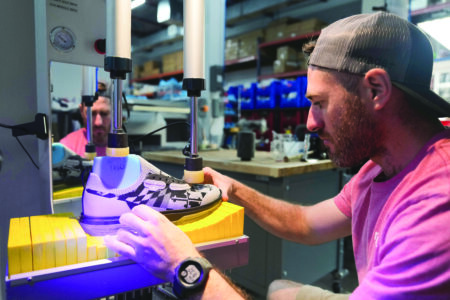Camp offers high school students head start on pilot career

Aiden Saer, left, listens to certified flight instructor Chris Olds, center, go over the pre-flight checklist for the Diamond DA20 at the Summerville Airport Wednesday, July 14, 2021, in Dorchester County, S.C. Seven high school students and recent grads are participating in CRAFT’s first-ever summer camp from July 11 to 23 at the Summerville Airport. The goal of the camp is to give high schoolers a head start on receiving a pilot’s license, said Jay Aldea, co-owner of CRAFT. (Gavin McIntyre/The Post And Courier via AP)
SUMMERVILLE, S.C. — Minette du Plooy wants to fly.
The 18-year-old from Prosper, Texas, has her mind set on becoming an Air Force pilot. She’s so committed that she convinced her parents to drive three days and book a hotel in Charleston so she could spend two weeks learning from instructors at a CRAFT Flight Training and Simulation camp.
The decision, and all that came with it, were worth it.
“It’s incredible,” du Plooy said. “I wouldn’t change giving up two weeks of my summer to do this.”
Seven high school students and recent grads are participating in CRAFT’s first-ever summer camp from July 11 to 23 at the Summerville Airport. Most of the students come from around South Carolina, with du Plooy being the only person to travel across state lines.
For the inaugural camp, the flight school reached out to the Lowcountry Aviation Association and Charleston Southern University to find students interested in participating.
The goal of the camp is to give high schoolers a head start on receiving a pilot’s license, said Jay Aldea, co-owner of CRAFT. By the end of the camp, the students earn an endorsement to take the Federal Aviation Administration’s private pilot exam.
PREPARING FOR TAKEOFF
The students go into the camp at any skill level. While some entered with hours of flying experience, others, like du Plooy, had only been in a plane one or two times.
The students spend each day cycling through three different types of lessons: ground school, simulator training and flight.
In ground school, the students learn everything they need to know for their written exam. They spend about four hours nestled in a small classroom in the airport taking lessons from an instructor.
The school teaches them the mechanics of the plane and the rules and regulations. While it might seem like the most boring part of the entire experience, the ground schools lays the foundation for what the students will do later on.
“Sitting up there in ground school, it does not make that much sense,” du Plooy said. “But the next day when you fly, it makes so much more sense. It all fits perfectly together.”
The students then spend one or two hours in a simulator. They take the wheel of a large metal box outfitted like the cockpit of a plane and resembling an arcade game.
They learn to fly through a variety of conditions with limited visibility, using only the tools of the plane to navigate.
With those skills in hand, the students are then able to start flying. By the time the camps ends, they’ll have about 12 hours of flying experience with an instructor and learning the fundamentals including navigation, turns and acceleration. They’ll work their way up to slow flight, where the speed is slow enough that the pilot has full control.
The slow flight is crucial as it’s used whenever a pilot is taking off or landing the plane.
“It feels like the plane is on a stick or a needle,” Aldea said. “Having them comfortable in that type of environment or that type of flight regime, allows them to have confidence controlling the aircraft.”
By the end, the students should have the endorsement to do their solo flight, Aldea said. The solo flight and the endorsement for the private pilot’s exam are the first steps in a piloting career.
The camp has been eye-opening for its four instructors as well. Todd Brooks, who came to Charleston from the Washington, D.C., area for the camp, said he’s enjoyed experiencing the thrill of flying vicariously through his students.
“It’s usually their first time ever being in a small plane,” he said. “You see the lights click on a little bit and they think ‘wow this is so cool.'”
OPENING DOORS
Aldea hopes the camp can give the students a sense of their options when it comes to being a pilot.
“There’s a lot of misconceptions about being a pilot and what that entails,” he said. “A lot of folks think that they have to take the military route, and that’s not necessarily the case.”
For many, pursuing a career as a pilot can be daunting and inaccessible. Getting a pilot’s license is no small feat and can mean thousands of dollars in schooling. The flight camp alone costs students around $3,000.
Through connections with the Lowcountry Aviation Association and other groups like Women in Aviation, however, most of the students were able to secure scholarships and have the program fully covered.
Emmanuel Peterson, a rising senior at Georgetown High School, said he was able to attend the camp through a scholarship. Without the opportunity, he isn’t sure that he’d be able to afford flight school to do his solo flight.
Ultimately, Peterson wants to be a commercial pilot, a job that no one in his family has pursued before.
“It’s a career that’s out there … being able to go to new places every day,” he said. “It’s like a thrill.”
Aldea said the camp is also an opportunity to network with collegiate flight programs. The school has a partnership with Charleston Southern University, which is the first school in the state to offer a collegiate pilot program.
“A lot of people won’t be exposed to that stuff early on,” Aldea said. “That’s part of our mission here to expose students to a potential occupation and potential lifestyle.”
Although it is limited by space, CRAFT hopes to expand the camp in future years to include more students, Aldea said.





